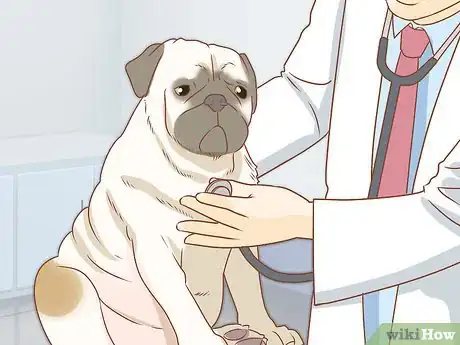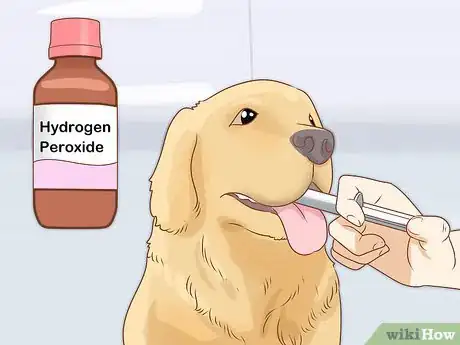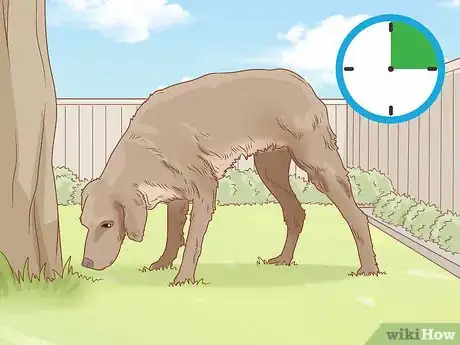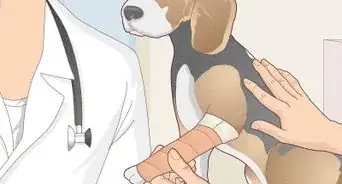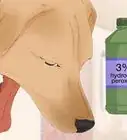This article was co-authored by Pippa Elliott, MRCVS. Dr. Elliott, BVMS, MRCVS is a veterinarian with over 30 years of experience in veterinary surgery and companion animal practice. She graduated from the University of Glasgow in 1987 with a degree in veterinary medicine and surgery. She has worked at the same animal clinic in her hometown for over 20 years.
wikiHow marks an article as reader-approved once it receives enough positive feedback. This article received 15 testimonials and 89% of readers who voted found it helpful, earning it our reader-approved status.
This article has been viewed 1,315,224 times.
Chocolate is toxic to dogs, as it contains a chemical called theobromine, which can cause elevated heart rates, increased blood pressure, and even seizures.[1] Dogs who have eaten chocolate must be treated immediately, as the larger the amount of chocolate and the longer it is in their system, the more danger there is for your pet.
Steps
Seeking Veterinary Attention
-
1Assess what type and how much chocolate your dog ingested. Make sure you have as much information on the chocolate and the amount of chocolate eaten when you get on the phone with your vet. The information will allow them to give you their best advice.
- Baker’s chocolate is the most toxic type of chocolate for dogs, while milk chocolate is the least toxic. Semi-sweet and dark chocolate toxicity falls somewhere in the middle. The toxic dose for theobromine ranges from 9 mg to 18 mg per pound. On average, baker’s chocolate contains 390 mg per ounce, semi-sweet contains 150mg per ounce, and milk chocolate contains 44mg per ounce.[2]
-
2Call your veterinarian for advice immediately. They will tell you the next steps to take, whether it is bringing your dog into their office or taking steps to help them at home.
- Small amounts of chocolate may only cause some diarrhea and stomach distress. However, it's best to contact your vet no matter how much your dog eats, as its reaction may vary.
Advertisement -
3Take your dog to the veterinary office, if recommended by your vet. Your veterinarian has the knowledge, staff, drugs and equipment to treat a chocolate overdose.
- Your veterinarian has drugs to cause vomiting if the ingestion was within the last hour or so.
- In some cases, your pet may need to be hospitalized for the night and a 24 hour emergency hospital is the best choice.
-
4Contact an emergency veterinarian if your normal vet is closed. Accidents don't always happen during office hours, so if you need advice during off hours, find an alternative veterinarian to give you advice or care for your dog.
- There are some clinics that specialize in animal emergencies. These places are usually open many hours and are a good place to take an animal in distress.
Inducing Vomiting
-
1Try to induce vomiting if advised to do so by your veterinarian. This should only be done if the chocolate was eaten within the last hour and there are no neurological symptoms (tremors) yet. Remember that there can be potentially lethal complications to making your pet vomit.
- Give the dog about one teaspoonful of hydrogen peroxide (3%). Combine with water at a ratio of 50:50. You are likely to spill a lot if you try to administer it with a spoon, so keep an oral dosing syringe handy in your doggy emergency kit.
-
2Watch your dog for about 15 minutes. Take it outside and watch it closely. This should help by just getting your dog moving. It will also be a better location for your dog to vomit.
- If the peroxide has not induced vomiting after 15 minutes, give the dog another dose and wait.
-
3Do not give anymore peroxide. If the dog has still not vomited after thirty minutes, do not give it another dose. Too much peroxide can harm him or her.
- There are possible side effects to ingesting Hydrogen Peroxide, even once. These include mild to severe stomach and esophagus irritation and inflammation, possible aspiration (getting the material in the lungs which could cause death) and even having bubbles form in the bloodstream (also potentially deadly).[3]
-
4Try giving your dog activated charcoal as a last ditch effort. Activated charcoal may help with preventing the absorption of the toxic elements of the chocolate from the intestines. A typical dose of charcoal is 1 gram of charcoal powder mixed with 5 ml (one teaspoon) of water per kg (2.2 pounds) of dog body weight.
- This is really a last ditch effort to help your dog in the absence of any professional veterinary care, and ideally should only be done on the advice of your veterinarian.
- You do not want to give activated charcoal to a dog that is vomiting, tremors or seizuring. If you get charcoal in the lungs, that can be fatal to the dog.
- It is very difficult to get a large amount of charcoal into a dog without a stomach tube, and you will need to repeat every 4-6 hours for 2-3 days. Note that your dog’s stool will be black and constipation is possible.
- Also, one serious side effect of charcoal administration is elevated sodium levels in the blood which can cause tremors and seizures.[4] These symptoms will look just like the neurological problems associated with chocolate toxicity.
- You will need to be very careful administering this product because it will stain fabric, carpet, paint, some plastics black, often permanently.
- If your dog does not eat the charcoal on its own, mixed with a little canned food, then syringing into their mouth may be needed. Unfortunately, this raises the danger level considerably because of the chance for getting the charcoal in the lungs and is therefore not recommended.
- Avoid using charcoal with Sorbitol repeatedly, as this increases the chances of diarrhea and dehydration and more serious complications for your pet.
Expert Q&A
-
QuestionMy dog ate a piece of brownie. Will she be okay?
 Pippa Elliott, MRCVSDr. Elliott, BVMS, MRCVS is a veterinarian with over 30 years of experience in veterinary surgery and companion animal practice. She graduated from the University of Glasgow in 1987 with a degree in veterinary medicine and surgery. She has worked at the same animal clinic in her hometown for over 20 years.
Pippa Elliott, MRCVSDr. Elliott, BVMS, MRCVS is a veterinarian with over 30 years of experience in veterinary surgery and companion animal practice. She graduated from the University of Glasgow in 1987 with a degree in veterinary medicine and surgery. She has worked at the same animal clinic in her hometown for over 20 years.
Veterinarian This depends on the size of your dog and how much brownie she ate. Most of the toxicity issues are related to dose. Since a brownie is only part chocolate, a large dog who stole a small piece is most likely going to be fine.
This depends on the size of your dog and how much brownie she ate. Most of the toxicity issues are related to dose. Since a brownie is only part chocolate, a large dog who stole a small piece is most likely going to be fine. -
QuestionThree days ago, my dog ate dark chocolate and was sick. Now she has a tender stomach, is off her food, but is drinking. What should I do?
 Pippa Elliott, MRCVSDr. Elliott, BVMS, MRCVS is a veterinarian with over 30 years of experience in veterinary surgery and companion animal practice. She graduated from the University of Glasgow in 1987 with a degree in veterinary medicine and surgery. She has worked at the same animal clinic in her hometown for over 20 years.
Pippa Elliott, MRCVSDr. Elliott, BVMS, MRCVS is a veterinarian with over 30 years of experience in veterinary surgery and companion animal practice. She graduated from the University of Glasgow in 1987 with a degree in veterinary medicine and surgery. She has worked at the same animal clinic in her hometown for over 20 years.
Veterinarian After three days, the toxic ingredients in the chocolate will have cleared her system. However, the richness of chocolate can trigger pancreatitis, which is an inflammation of the pancreas. This is a painful condition which causes vomiting, loss of appetite, and diarrhea. Make sure she is drinking, and only offer bland food (such as chicken and rice) to eat. If she does not improve within a few hours, see a vet.
After three days, the toxic ingredients in the chocolate will have cleared her system. However, the richness of chocolate can trigger pancreatitis, which is an inflammation of the pancreas. This is a painful condition which causes vomiting, loss of appetite, and diarrhea. Make sure she is drinking, and only offer bland food (such as chicken and rice) to eat. If she does not improve within a few hours, see a vet. -
QuestionMy dog ate milk chocolate raisins. He is acting normally, but should I be worried?
 Pippa Elliott, MRCVSDr. Elliott, BVMS, MRCVS is a veterinarian with over 30 years of experience in veterinary surgery and companion animal practice. She graduated from the University of Glasgow in 1987 with a degree in veterinary medicine and surgery. She has worked at the same animal clinic in her hometown for over 20 years.
Pippa Elliott, MRCVSDr. Elliott, BVMS, MRCVS is a veterinarian with over 30 years of experience in veterinary surgery and companion animal practice. She graduated from the University of Glasgow in 1987 with a degree in veterinary medicine and surgery. She has worked at the same animal clinic in her hometown for over 20 years.
Veterinarian This is double trouble because both raisins and chocolate are toxic to dogs. The chocolate acts quickly (within minutes or hours), so if he's okay, that's good news. However, raisins can cause kidney failure, which might not show for days and weeks. It's best he has a blood test at the vet's to check if damage was done.
This is double trouble because both raisins and chocolate are toxic to dogs. The chocolate acts quickly (within minutes or hours), so if he's okay, that's good news. However, raisins can cause kidney failure, which might not show for days and weeks. It's best he has a blood test at the vet's to check if damage was done.
Warnings
- You may not be able to treat the dog by yourself. Call your veterinarian immediately.⧼thumbs_response⧽
- Do not let the dog eat chocolate again, even if they have not physical reaction to it. Different chocolates will affect dogs differently. Don't risk it. Keep all chocolate locked safely away from your pets.⧼thumbs_response⧽
- Too much peroxide could potentially do even more harm to a dog. Do not give any more than two doses of it. Better yet, only give Hydrogen Peroxide based on your veterinarian’s recommendation.⧼thumbs_response⧽
- NEVER give your dog any amount of chocolate of any kind. You can never be sure it will do no harm, and even if it doesn't harm your dog at all, you are teaching your dog to see chocolate as a yummy treat, potentially encouraging it to go asking or looking for more.⧼thumbs_response⧽
- The fat in chocolate may trigger vomiting and diarrhea in dogs, even if they do not get toxic doses of theobromine. In addition, pancreatitis may result secondary to chocolate ingestion (triggered by the fat content), which may resolve on its own with a bland diet (non-fat cottage cheese and white rice) for a few days, or may be serious enough to require hospitalization.[5]⧼thumbs_response⧽
References
- ↑ http://www.veterinarypartner.com/Content.plx?P=A&S=0&C=0&A=3544
- ↑ http://www.veterinarypartner.com/Content.plx?P=A&S=0&C=0&A=1762
- ↑ Plumb, Donald C.; Plumb's Veterinary Drug Handbook: 7th (seventh) Ed.; Wiley-Blackwell. 2011
- ↑ Plumb, Donald C.; Plumb's Veterinary Drug Handbook: 7th (seventh) Ed.; Wiley-Blackwell. 2011
- ↑ http://www.veterinarypartner.com/Content.plx?P=A&S=0&C=0&A=1762
About This Article
If your dog has eaten chocolate, try to figure out what type of chocolate they have ingested, since baker's chocolate has more chocolate in it and can be more dangerous than white chocolate, which has a low chocolate content. Then, call your veterinarian immediately to tell them how much and what kind of chocolate the dog has eaten. If they recommend bringing your dog in, take them there or to an emergency vet for treatment. The vet might also advise you to induce vomiting and observe your dog. For advice from our veterinary reviewer on inducing vomiting, scroll down!


